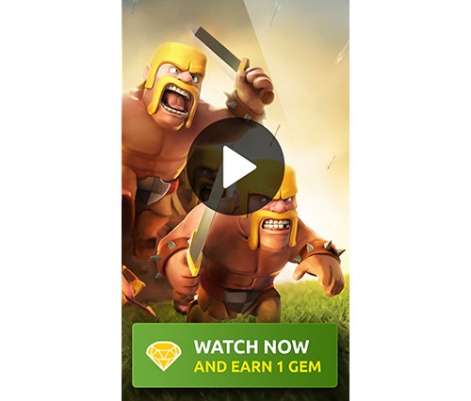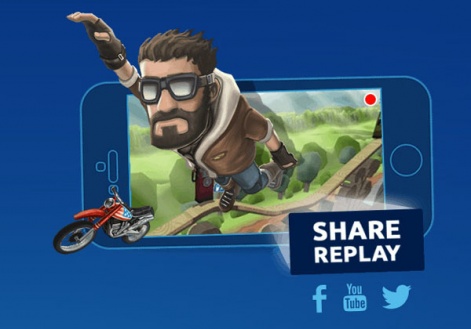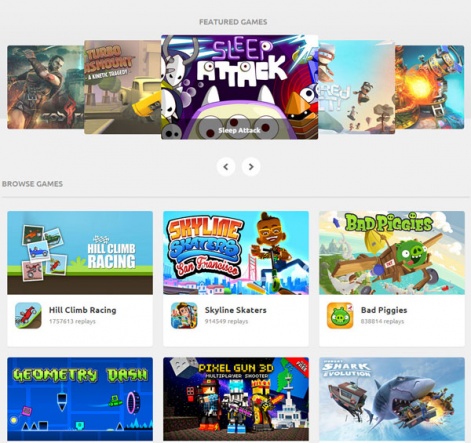AppInTop is an automated mobile app marketing platform that combines the mobile traffic from 30 countries into a single interface.
It also runs a regular marketing podcast, with PocketGamer.biz publishing transcripts from the most interesting discussions.
You can subscribe to the podcast via iTunes here or listen to this episode here.
In this week's article we spoke with Mickey Maher, the former general manager of US at Applifier, now senior director of business development at Unity Technology, about effectiveness of video ads and how to use video game replays in mobile game marketing.
Unity Technologies makes a very successful gaming engine, so what was the acquisition of Applifier about?
Mickey Maher: The acquisition of Applifier means that Unity developers will have full access to our technologies, the Everyplay product and UnityAds, and the video ad network, without an SDK integration.
These products will eventually be baked into the engine, so Unity developers can just click a button and will have ads and a game replay-sharing technology seamlessly.
What kind of decision went into buying a CPI network?
So when you think about what Unity is, it's an engine that helps game developers build the game. But the company wasn't really having too many touch points with developers post-launch, and as games become games-as-a-service, we wanted to be involved and help our developers be successful post-launch.
We want to help our developers be successful and we feel the services business is the next step in our evolution as a company to be able to do that.Mickey Maher
It's really important to have the services business, analytics, ads, cross-promotion, Cloud -building, and game replay sharing to help our Unity developers throughout the whole process of building and maintaining a game.
We want to help our developers be successful and we feel the services business is the next step in our evolution as a company to be able to do that.
Let's say I'm an app developer. I either monetize my apps by displaying video ads or I promote my apps through video ads. Convince me to use video to promote and monetize mobile apps.
You are trying to advertise an experience to the user, and this experience cannot be conveyed in banners or aesthetic interstitials. The best way to advertise an entertainment experience is through video. Video will get you the most prequalified user and typically the highest quality users. So if you can afford it, buying the video ad is the number one way to go.
Then on the flip side, if you are going to show ads in your game, I would highly recommend video. It pays at least twice, if not three times, as much as banners on a per impression basis and 1.5 to two times static interstitials.
So if you're looking to monetize with ads, you might as well use the ad unit that pays most, which in our experience has been video.
Can banner ads still be effective?
I think there is a place for banners. I would recommend using banners in a different inventory than you would with video or with high-premium ads.
Let's take Flappy Bird for instance. People like Flappy Bird but the game just had AdMob banner ads layered on the game.
They could have generated three to four times the revenue if they would have been more strategic and used video or some kind of larger interstitial. It's just a much, much higher paying ad unit.

If I look at a banner for a game, it's a picture of a character on the game and it says, "Play this awesome war game."
I, as a user, have no idea what the quality is. Clash of Clans is one of the best mobile games out there, but a banner for Clash of Clans doesn't tell you what Clash of Clans is. Users don't know what the mechanics look like, what the gameplay is.
But with video, you can structure it to showcase exactly what that experience looks like, so when the user is watching the video and clicks through, they have a pretty good sense of what they're getting into.
What do you think of the new format of interactive advertising, where a user can play through multiple levels within the ad?
I have my questions about that type of advertising. I've looked into it pretty deeply. There's no real hard data to say yes or no, but when I think about it from someone who is showing ads to the users in game, playable ads...
It's hard enough to get a publisher or game developer to show video ads. It seems like it's just too immersive in their game.
Playable ads take it a step further. Video ads are probably much shorter than what these playable ads would be. So taking a user out of the game for 30 seconds to play another game within that game as an ad... I don't know how much game developers are going to adopt that technology. Time will tell, but I have my questions on it.
What is an optimal length for a video ad?
Advertisers usually try to get us to do 30- or 60-second videos, but we found a nice balance is 15 to 18 seconds.
On average 15 to 18 seconds is more than enough for a video ad.Mickey Maher
There are some mobile games that are very deep and they probably need a little bit more, so maybe 20 or 22 seconds, so a couple more clips of gameplay, but on average, 15 to 18 seconds is more than enough.
What should be in the video to grab the user's attention to get them to install the ad?
When you think about what the advertiser's goal is, they're buying by performance base, so they're paying a CPI for a user that they hope is going to come into the game, be retained for a certain amount of time and hopefully spend money. That's the goal, right?
But sometimes these advertisers want to launch movie-style trailers to drive users Well, a movie-style trailer has similar effects of a banner. I've just got all these bells and whistles in this grandiose trailer that doesn't really show the user what they're getting into, although it's driving a large scale of users to the game because it's an awesome trailer, but it's not necessarily pre-qualifying the user.
So you're paying the CPI, and a premium CPI because it's a video, you're paying for a user that's not necessarily prequalified.
Moreover, use some nice art work, polish it up a bit, but with as much gameplay as possible; show the user the mechanics, exactly what the experience looks like, and this will drive a user that will be more likely to be retained, and hopefully you can monetize them down the line.
There are so many so-called Let's Players out on YouTube there. Some of them have more than a million views, some skyrocket above that. How do they impact the promotion of an app?
I think it has a huge impact on app promotion and visibility. One of our partners, Geometry Dash by RobTop Games use Everyplay, and fortunately for them, PewDiePie found them and did a video on Geometry Dash.
We saw the user base, I can't really talk about the numbers, but we did see a huge spike in that game's user base just from 15-second clip of PewDiePie reviewing the game. Over a week or two-week period, we saw a huge spike in shares of Everyplay videos.
How do you get one of these guys to do it? It's probably a lot the same way as you get Apple to feature you. You build a relationship, reach out, flatter them, and stay hungry, stay on them, and if you have a quality game and you're in their face all the time, there's probably a higher potential than not that they'll do something.
Let's say the review of my game was watched by 100,000 people, how many installs do you think I'll get, and what is that going to cost me?
If we're talking specifically about Everyplay, the user-generated videos from Everyplay for a high quality game usually see a 15% to 20% click-through rate to the App Store, and video ads usually deliver around a 20% install rate.
At 100,000 people, you'll have 20,000 click-throughs to the App Store, and then you may get 3,000 to 4,000 installs.
Everyplay is a free solution, so driving installs from Everyplay means getting organic users and there's no cost.
What do you think of Apple's fight against incent video ads?
I think Apple has given up that fight for now, and my official position on it was that this is much different than incentivized installs. Incentivized installs is a way to game the App Store, right?
Incentivized view, not incentivized install, really has no effect on the App Store. These are real installs. We're just enticing or rewarding the user to actually engage in the ad. Once they engage in the ad, then it's completely up to them whether or not they want to install the game.
Whether I give them points to watch the video or whether it's an interstitial video, it's the same quality more or less coming to the game developer.
If there is no incentivized inventory left, if Apple bans it, then it just reduces the scale of installations because a lot of them come from the incentivized version of the video ad.
I would say 50% of our traffic is in non-incentivized skippable interstitials: between levels and between gameplays. Would this ban reduce the installs? Yes, but it won't kill the whole ecosystem of video ads.
Unity Technologies acquired Applifier to let its customer base benefit from Everyplay. Please tell us about Everyplay, and what it's about?
It's pretty simple concept. You stick an SDK in game. That SDK will allow the gameplay to be recorded as well as your user's audio and visual commentary through the FaceCam. Then that game replay plus the user audio and video commentary can be shared to the user's favorite social network via Facebook, Twitter and YouTube.
Everyplay also has their own social network that is quickly approaching 20 million users where the user can also share to and join and engage in their favorite game videos.
What are some success stories that you're seeing here with Everyplay? Is there a chance that Everyplay can help get an app to the top of the charts in app stores?
I think if it's done right, and the integration is great, and the game is high quality and everything comes together, it can certainly affect your position.
A perfect example is Skyline Skaters from Tactile Entertainment. They integrated Everyplay before they launched. When they launched, they had 95,000 videos shared in the first weekend and 400,000 to 500,000 in the first month. During that time, it was a top 5 or top 10 free game.

So it was a huge success story. They did a lot of things right, and they promoted Everyplay appropriately, and then they had probably some the most success we've seen with Everyplay.
Hill Climb Racing, which is a game that's been around a long time, has the most shares on our network. It is well over a million now, and where we stand today, it just hit over 1.5 million shares. Hill Climb Racing is having a huge success, as are Skyline Skaters, Geometry Dash, Bad Piggies from Rovio, and many, many others.
You're saying it's free for your users to use so how does Everyplay make money?
We make money by launching native ads within our network - it's an advertising-supported service.
Any users that games are getting from the organic shares, they're all free, and then if the games want to come in and buy more Everyplay users via video trailers through our Unity ads network, they can do that, and that's how we make money.
What kind of games are doing well on Everyplay?
The games that seem to do the best on Everyplay are games that either have a very competitive aspect to it or something that's very creative or a combination of both.
Bad Piggies, for example, just touches user's creativity. I would say 75% of the videos are users building and doing something cool that is very creative and sharing that. About 25% of Bad Piggies replays are competitive, how to, or showcasing. As in - 'How did I get three stars on this level.' It's almost instructional.
Another type of game that does really well and is very popular are shooters, whether it's third person or first person. We have a lot of shooters on Everyplay that do well. Battle Bears is one, also Pixel Gun 3D and Dead Trigger 2 from Madfinger.
What does the developer need to do to get game replays on Everyplay? What are the technical requirements involved?
The base is just a simple SDK integration, and if you are using the engine like Cocos or Unity, of course, there's a plugin. In the future, though, Unity developers won't have to do anything, but click a button within the Unity engine and it will enable the request. It is actually much more simple than the typical developer thinks it is.

It's one of the challenges getting it to the developers because developers always think, "Oh, this must be a very challenging integration or it's going to take huge amount of my developer's time."
We do have support for developers that want to integrate Everyplay. We have an API that lets you do some really cool stuff, and you can make Everyplay as custom as you want it to be.
Supernauts by Grand Cru has done some really cool stuff with our API, so if you want to see like the full feature set of Everyplay, I recommend checking out Grand Cru's Supernauts.
Let's say I'm an indie developer, and I feel like I've got a fantastic game, but not a lot of users. Any suggestions for me to get game replays noticed on Everyplay?
It's very simple, if you've got a good game and we like it and it seems like a good showcase of Everyplay and if you do the integration really well and correctly, it's something we think would be great to showcase, all you have to do is reach out to one of us and our Everyplay app has feature spots. We can feature it. The online website has feature spots too.
Also, we have community managers, and every one of our over 18 million Everyplay users automatically follows our community managers. Our community managers can do a video for the game and then it can reach 18 million users immediately.
This is an abridged and edited interview from the AppInTop mobile app marketing podcast produced by AppInTop, an automated mobile app marketing platform.
Listen to this podcast episode or subscribe to the podcast via iTunes.



















